Anchor text is an integral part of SEO which has a great impact on search ranking factors. It helps search engines to read your site and understand its relevance to the user’s search.
Anchor text optimization is one of the easiest SEO strategies that you can use to skyrocket your ranking.
But what exactly is anchor text and how you can use it to achieve your SEO goals?
That brings us to today’s post. Here are what you will learn:
- What is an anchor text?
- What makes a good anchor text?
- How will the anchor text affect your SEO strategy?
- What are the anchor text strategies you can use in 2022?
- What are the different types of anchor text you can use in your content?
Let’s start!
What Is An Anchor Text?
If you are wondering what is an anchor text, it is the visible and clickable text in a hyperlink that links to another location on the web.
Generally, anchor text appears as blue and underlined like this: Lead generation mistakes. You’re probably familiar with that already. These days, we can see many websites use different styles and colors for links.
How to add anchor text to links? It’s easy, really. Just highlight the text and click ‘Ctrl + K’. Then, enter your links.
This is how anchor text looks like in HTML:
<a href=”https://biq.cloud/blog/lead-generation-mistakes/”>Lead generation mistakes</a>
Anchor text is an integral part of SEO which has a great impact on search ranking factors. A good anchor text strategy helps search engines to read your site and understand its relevance to the user’s search.
For example, if we look at the anchor text below, “ideal length of content”, we can guess that it will lead to a page that talks more about the topic of ideal length for content. Well, that’s how it is supposed to be.

The “ideal length of content” is an anchor text that leads to this blog post- https://seopressor.com/blog/the-ideal-length-for-every-online-content/. The linked source talks about what is the ideal length for every content.
Using the anchor text in the excerpt above helps the readers to know what to expect if they click them.
Anchor text and SEO: Is anchor text strategy important for SEO?
The short answer is: YES!
Anchor text gives important information to not just the reader but search engines too. It helps search engines to understand the context of the website and gives a clear idea of your website and what it is all about.
Looking back at the previous example, “ideal length of content”, search engines understand the referred page is about a content’s ideal length.
The keywords in the anchor text are one of the many signals search engines use to determine the topic of a website.
It analyzes the anchor text people use when linking to websites to see how authoritative a site is on various topics. Websites are more likely to rank high in search results for keywords related to them.
Now, let’s look at the example of a good and bad anchor text:
Bad anchor text
Click this link, click here
Using “click this link” as your anchor text will not tell much about what the referred link is about. It could lead the user to content that does not match their interests.
As a result, it will increase the website’s bounce rate and this gives a bad signal to the search engines.
Good anchor text
Anchor text vs hyperlink, how does anchor text work, anchor text generator
Using a descriptive anchor text helps Google’s bots to instantly understand what the linked page is about. It will help pages rank for queries related to the topic. Most importantly, the users will have a better idea of what the linked page is about.
Anchor text for backlinks, internal links, and external links
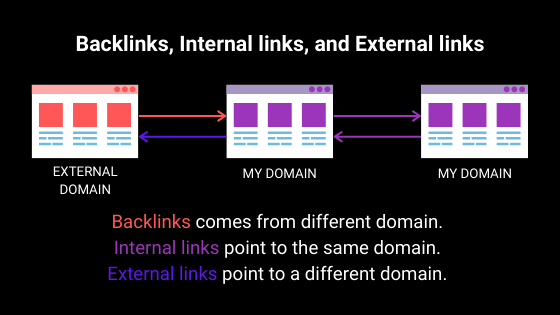
Backlinks – links that come from someone else’s website to yours
Internal links – links that direct the readers to the target page on your own website
External links – links that direct the readers from your website to a different website
As a rule of thumb, you can’t really influence the anchor text of your backlinks, but you can do so for your internal link building or also known as “inlinking”.
By linking related pages internally, you can actually boost your rankings on Google. Your website structure is used to determine the quality of your on-site SEO. And a good inlinking is the key to it.
Thanks to anchor text, it makes the linking easier to understand for your readers and search engines as well. Hence, Google bots will be able to freely crawl through your website which directly improves your site’s SEO.
Read more on how to use an internal link to quickly boost your website’s ranking position (You guessed it right, this is another example of anchor text!).
Best Practices: Anchor Text Optimization Strategy
Now, what makes a good anchor text strategy? Know that using good anchor text practices can result in a positive impact on your SEO.
In this section, you will get to know how to optimize your anchor text for better SEO performance in 2022.
Let’s dive in!
1. Keep anchors relevant to the content
Keep this in mind: always do it for the searchers’ best interest.
Google or any other search engines always want to offer the best and relevant information to their users.
Unfortunately, not all anchor texts are able to deliver what they have promised. This results in a high bounce rate and low average time on site. Thus, the lower ranks on search results.
The next time you want to create an anchor text, ask yourself this question: how relevant is this anchor text to the referred link?
If the anchor text is “social media engagement strategy”, the destination link should talk about topics that are related to a social media engagement strategy. For example,
- Tips to improve my social media engagement
- Social media engagement examples
- How to increase social media engagement organically
Just imagine if any of the anchor text above leads you to a pet shop website… It does not make sense in any way, right? Would you find it relevant or valuable to you? I’m sure it’s 100% no and it would be the same for Google. The anchor texts should (always) offer real value to the users.

2. Keep your anchor text natural
Your anchor text should be natural in the eyes of readers. It must flow naturally within your content.
Always remember that you are writing for humans and not bots. To give you an example, exact match anchors often don’t look natural in the context of a web page.
We will look further into the different types of anchor text in a while.
When you try to force a specific exact match anchor text on your content, your reader and the search engines will easily notice.
As we all know, Google’s algorithms are getting smarter every day. Therefore, you should avoid using multiple repetitive and keyword-based anchors on your web page. It doesn’t do any good to you especially when Google detects them. Failure to do so may result in a penalty.
Google is now becoming more and more rewarding to quality content that uses sentence structure variations. By using anchor text naturally, you are more likely to see better results in the long run.
3. Keep your anchor text brief
More is not always better. There is no restriction on an anchor text length but it is best to keep it short and sweet.
To illustrate this better, let’s look at the example below:

Using anchor text that has too many words does not really help readers, but only making it hard to understand and lose track of what you’re linking to.
Here’s how you can fix them:

Shorter anchor text length definitely helps readers to read them and know what to expect.
4. Make your anchor text stand out
Why would you hide the anchor text when it does not serve its purposes?
Anchor texts are there to let readers notice and click the link when it is relevant. Therefore, you may want to make sure your readers can easily see the links in your content.
I am very sure we are already familiar with the common blue underlined text, but we are not limited to just that. We are free to express our creativity using other colours and styles, as long as it helps readers to see it is a clickable text.
Let me share with you some examples that I’ve found on how you can style your anchor text. Anchor text example:
Example 1: Red color

Example 2: Purple color

Example 3: Bold and underline
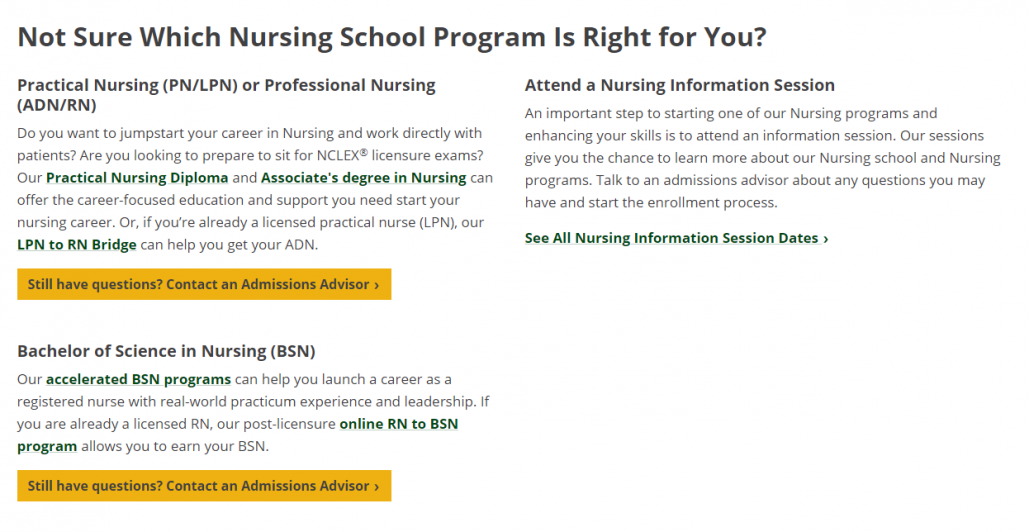
It is actually pretty easy to change your link’s color.
<a href=”yourlinkhere.com” style=”color:red”>Text here</a>
Just change ‘red’ to your preferred color and it is done!
How do you make sure your anchor text stands out in your content? I would love to hear from you. Do let me know in the comment below!
5. Distribute your anchor text in the right proportions
Some may have overlooked this important practice; the distributions of your anchor text should be proportionate.
It’s hard to tell the ideal distribution of an anchor text, but it is best to avoid overstuffing with exact match and partial-match keywords on your content. You can rely on branded and website name anchor texts as it is allowed by the search engines.
Here are the suggested anchor text percentages that you can use when optimizing your anchor text strategy.
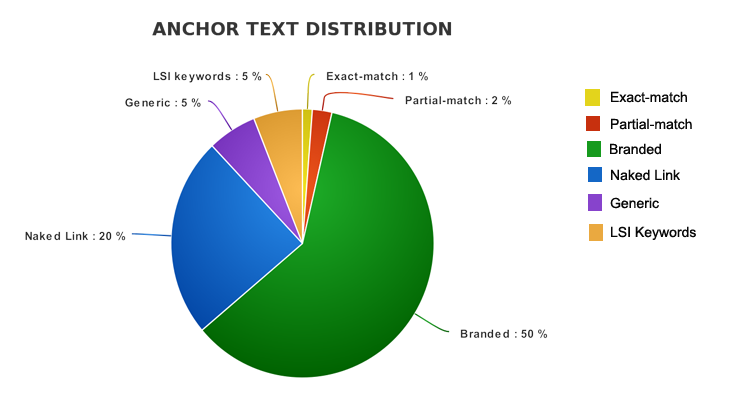
Check out the top-performing website anchor text distributions in your niche or industry. Explore and discover their distribution percentages of the different types of anchors to get a good idea of what they have been practicing to gain the top ranking.
6. Don’t over-optimize
Everything has its own limit. Avoid overstuffing with exact match keywords because it may result in penalties. Using the same keyword too many times does not bring any good to your site. Not just in the eyes of the Google bots, but also readers.
In short, keep your anchor text natural and spread it across your site in an appropriate proportion.
7. Track your hard work
Tracking your anchor texts is a must. Track the percentages of all kinds of anchor text. It is to make sure that you are not over-using certain keyword anchors for one particular web page.
Failing to do so means you will risk falling into the “over-optimized” category. Also, you don’t want to let your hard work go to waste.
Tracking your anchor text would help you to follow a systematic process and avoid overusing keywords that are already used.
Here is the anchor text strategy checklist that you can start optimizing to boost your SEO:
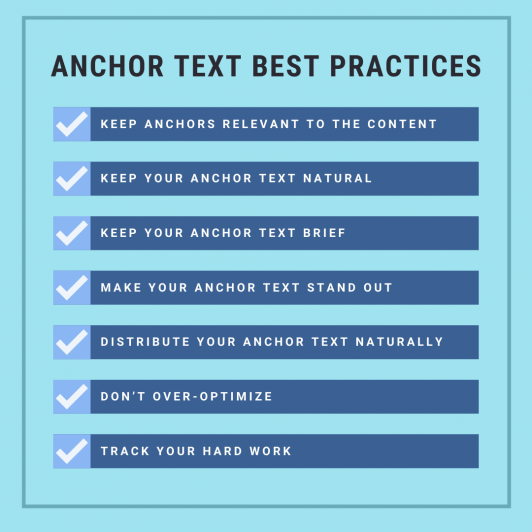
Types of Anchor Text
As a matter of fact, there are different types of anchor text you can use.
Here are the six common types of anchor text that you may have noticed on different websites.
1. Exact match anchors
Exact match anchor text includes the exact keyword or phrase that you are targeting. The exact match would be exactly the keyword that you want to rank for on the search engine result page. It is without any keyword variations or diversification.
Example: Rank Intelligence by BiQ will help you to discover rankings that you may not have known.
If “Rank Intelligence” is my target keyword, then my exact match anchor text would be “Rank Intelligence”.
Exact match anchors are known to have the power to increase your rankings. At the same time, it also has the power to get your site penalized by Google. This is because using the same exact keyword excessively leads to keyword stuffing.
Instead of using the same keywords all over again as your anchor text, you can go to BiQ’s Keyword Intelligence to find related keywords for your main keywords.
Simply enter your main keyword and you will see a list of useful related keywords that you can use as your anchor text.
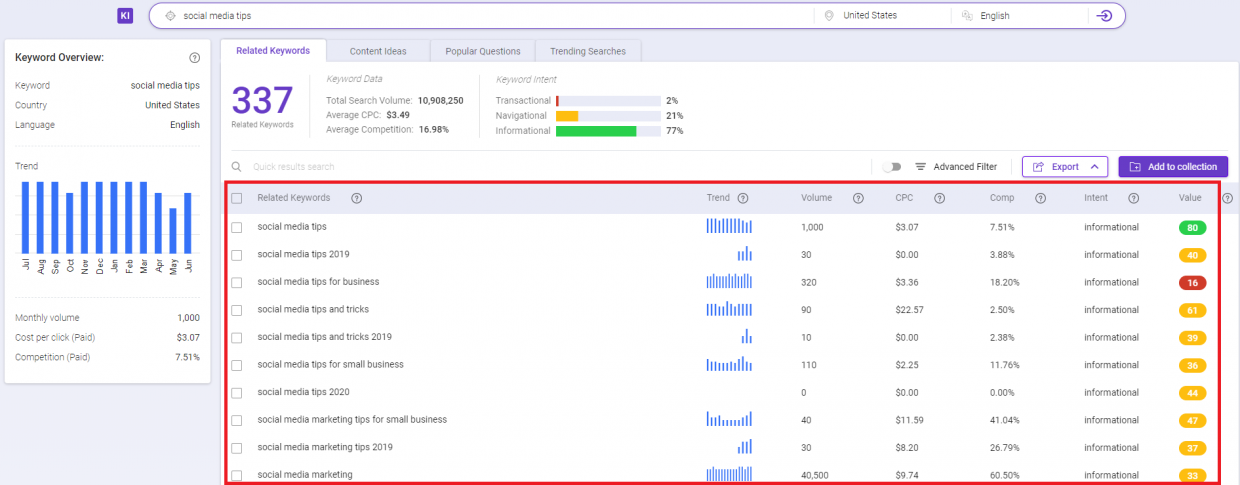
2. Partial match anchors
Partial match anchor text includes your target keyword with some variation. It has all the keywords of your target keyword but is not an exact phrase.
Example: BiQ’s latest Rank Intelligence will help you to discover rankings that you may not have known.
The keyword variation for the anchor text above is “latest”. Using keyword variations is a more organic alternative to using the same keyword repeatedly on a page.
It’s easy to add variations to your target keyword. Click the ‘Advanced Filter’ in BiQ’s Keyword Intelligence, and include your target keywords.

3. Branded anchors
Branded anchor text contains your business’s brand name and it is unrelated to your target keyword.
Example: Rank Intelligence by BiQ will help you to discover rankings that you may not have known.
“BiQ” is a branded anchor text as it is the name of an SEO Suite. Branded anchors are the safest type of anchor text.
4. Naked link anchors
Naked link anchor text means the URL itself is being used as the anchor.
Example: Rank Intelligence by BiQ (https://biq.cloud/) will help you to discover rankings that you may not have known.
The link is described as “naked” because you can see the whole URL is displayed as its own text.
5. Generic anchors
Generic anchor text is the common anchor that you see everywhere. It is completely unrelated to the link that you’re linking to.
Example: Click here to see how Rank Intelligence can help you to discover rankings that you may not have known.
Generic anchor text uses non-specific keywords or phrases like “learn more”, “click now”, “more info”,” read here”, or “click this button”. It encourages the readers to click but may not be able to tell them what the content of the referred link would be about.
This may hurt the user experience if the content of the referred link is not able to deliver what the user wants.
By adding a short description before using the generic anchor text would help the user to know what to expect before clicking the anchor text.
6. Image anchors
There isn’t any actual anchor text for images but there’s what we call an alt tag. The alt tag is a description of what the image is about.
Example: <a href=”https://biq.cloud/”><img src=”/rankintelligence.png” alt=”BiQ’sRank Intelligence”/></a>
It’s obvious that search engines cannot interpret images. Because of that, the alt tag plays an important role by telling search engines what the image is about. The alt tag should be kept short to maximize its impact.
One thing to take note: Don’t excessively use the same alt tag as this will lead to keyword stuffing. Again, the search engines disfavor such a strategy.
To recap, here are the 6 types of anchor text for your reference.
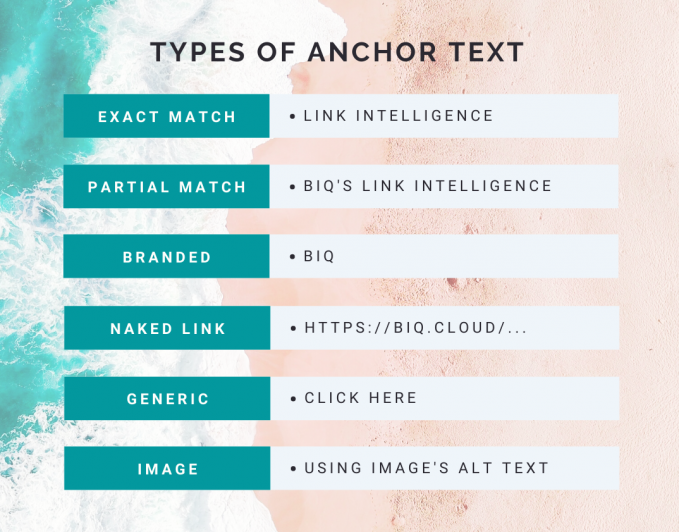
Conclusion
In 2022, anchor text still has a big impact on SEO, but the game has changed. To make it work effectively, keep your anchor text natural. Make sure it is not over-optimized and maintains a good proportion of keywords to help boost your ranking.
You can’t really control who links to your site and the anchor text they use to link you. So try your shot at internal linking.
The best part about internal linking is you can control the anchor text used within your site. With this in mind, I would suggest you to use the anchor text best practices to govern how to best use anchor text within your own website. When done right, anchored links will help to enhance user experience on your website.
Can you see how anchor text strategy applies to your SEO strategy in 2022?




